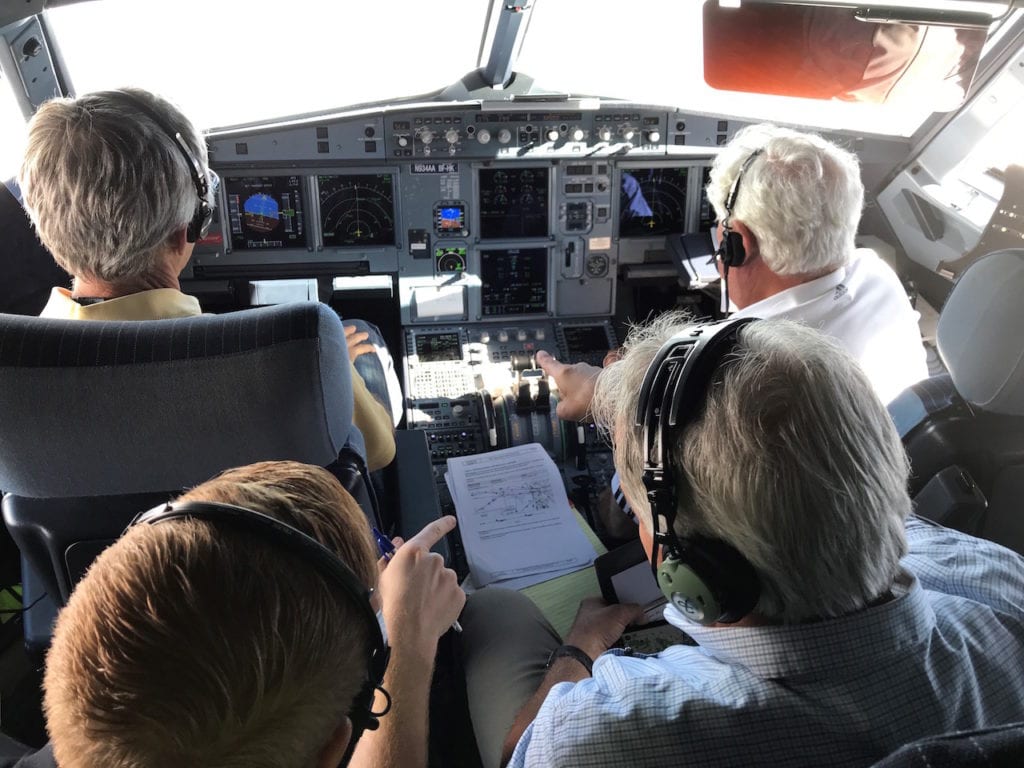
Pilots and engineers from American Airlines and L3Harris recently completed flight tests evaluating the use of SafeRoute+ ADS-B In retrofit technology. Photo: L3Harris
American Airlines is in the final stages of obtaining certification on the use of automatic dependent surveillance broadcast (ADS-B) In, a cornerstone technology of the FAA’s ongoing NextGen airspace system modernization program, after completing recent ground and flight tests with a retrofitted system capable of enabling its use in U.S. airspace.
Over the next three to four years, American will be equipping a fleet of more than 300 Airbus A321 aircraft with SafeRoute+, a line of commercial air transportation flight deck displays designed to support ADS-B In. American and L3Harris are currently awaiting a final technical standard order (TSO) certification from the FAA, which will allow the installations of SafeRoute+ and other components required to enable ADS-B In applications.
These applications include cockpit display of traffic information (CDTI) assisted visual separation (CAVS) and an initial version of interval management (IM), which is an ADS-B In application that gives pilots more control over the spacing of their aircraft relative to other ADS-B equipped aircraft arriving at busy airports.

A display in the American Airlines ADS-B In flight test aircraft shows the flight path during testing. Photo: L3Harris
During separate flight tests on September 15 and October 27, the ACSS engineering team—ACSS is a joint venture between L3Harris and Thales—and the FAA participated in flight testing of SafeRoute+ on an American Airlines A321 aircraft. The testing is part of ADS-B In Retrofit Spacing Evaluation (AIRS) project, that first began in July 2016. SafeRoute+ is described by ACSS as an ADS-B In retrofit display for commercial airliners, that uses traffic collision avoidance system computers to host ADS-B In applications and populate them on navigation displays.
ACSS had previously only been able to display Saferoute on class 3 electronic flight bags (EFBs), however, now that capability can be added to aircraft in a less costly display integrated directly into the avionics.
“While the system delivers exceptional situational awareness in all phases of flight, it’s most valuable during the critical approach phases of the flight,” Dave Surridge, an A321 captain for American Airlines said in a statement published by L3Harris. “This new technology brings the same aircraft-specific data that ATC uses into the flight deck, and that allows flight crews to get a more complete picture of what the ADS-B equipped aircraft around them are doing.”
Representatives for L3Harris described the process of upgrading the first two American Airlines A320 aircraft for the test flights as taking just three days to complete. The certification flight test removed two American aircraft from revenue service, one of which had previously modified with updates to the wiring that capped and stowed the wiring to accommodate the SafeRoute+ system.
The process required two days where the Saferoute+ system was installed and ground tested, before the aircraft then participated in the actual flight test.
“The aircraft spent a total of three days out of service. The second aircraft functioned as the lead aircraft and, therefore, only required ADS-B Out capabilities and did not require SafeRoute+ to be installed. This second aircraft was out of service for one day. American Airlines is currently quoting five to six years for project completion with the opportunity to outfit the entire fleet of A320 aircraft with this system as the benefits are realized. Activations of American’s aircraft are planned for January 2020. At that time CAVSS ADS-B In operations will begin,” Robin Glover-Faure, vice president of sales for commercial aviation at L3Harris told Avionics International.
Faure, a former British Airways pilot, said the early feedback from American has been positive, with pilots such as saying that they’re able to make better real-time decisions based on the stage of a flight they’re in. Initially, American will look to use ADS-B In for CAVS, with the eventual goal of flying the airport arrival concept known as flight deck interval management (FIM). Current air traffic control technology and procedures can predict arrival times to within a minute or so—but FIM is expected to enable controllers and airports to count on aircraft arriving within five to 10 seconds of a predicted time. As a result, FIM enables air traffic controllers and pilots to reduce the interval required between airplanes landing on a runway.

The ACSS and American Airlines team with the ADS-B In equipped aircraft. Photo: L3Harris
Boeing, Honeywell and NASA made headlines in April 2017 after performing flight deck-based IM trials involving Honeywell’s Boeing 757, Dassault Falcon 900 and United Airlines Boeing 737 aircraft. The trial proved that the addition of algorithms using NASA’s trajectory-based airborne spacing for terminal arrival routes (ASTAR) solution can enable a chain of airplanes approaching an airport to use a new set of air traffic control (ATC) voice clearances directing flight crews to achieve and maintain a given time-based or distance-based longitudinal spacing behind a target airplane.
American Airlines’ goal for IM on its A321s will be to achieve and maintain desired spacing intervals, according to ACSS.
“We see a substantial opportunity for growth in ADS-B in because its benefits will clearly have to be proven, but those are becoming self evident that as we have seen in the testing process,” Faure said. “The ability of this technology to safely flow traffic through congested airspace and into the terminal management area of airports can increase the amount of capacity in a safer way, as air traffic volumes continue to grow. American is obviously still in the earliest stages, but I think once the benefits for their pilots are clearly proven, other operators will start to look at investing in ADS-B In as well.”